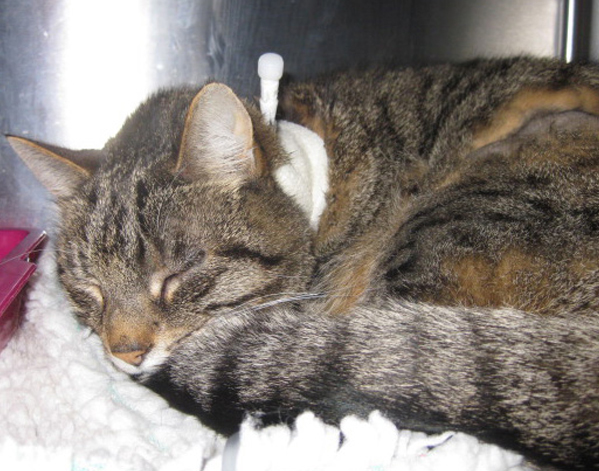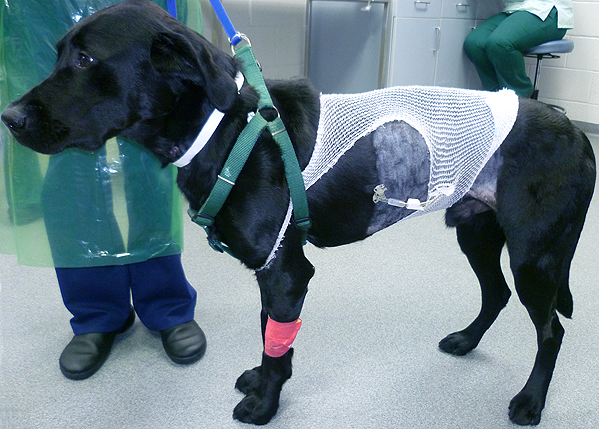How Does a Feline Catheter Feeding Tube Function
Feeding tubes in cats and dogs
What are feeding tubes?
Feeding tubes are used to feed cats and dogs that are either ill and have lost their appetite, or have a condition which means that they are unable to eat, even if they may still want to. One end of the tube is outside the body – a syringe filled with liquid food is attached to this end of the tube to pass the food down the tube. The other end of the feeding tube is either in the oesophagus (the 'gullet'), the stomach or the intestine.
Feeding tubes can be passed into the body through the nose (called a naso-oesophageal feeding tube), or through the skin of the neck into the oesophagus (called an oesophagostomy feeding tube), or through the wall of the abdomen into the stomach (called a gastrostomy feeding tube) or into the intestine (called a jejunostomy feeding tube). Oesophagostomy feeding tubes are very commonly placed, whereas jejunostomy tubes are rarely used.

A cat with an oesophagostomy tube comfortably in place

A dog with a gastrostomy tube, which allows food to be introduced straight into the stomach
Why does my pet need a feeding tube?
Feeding tubes are usually placed in a dog or cat that is not eating. Sometimes feeding tubes are also placed when the pet is keen to eat but has difficulty swallowing or keeping the food down.
How is the feeding tube placed?
Apart from a naso-oesophageal feeding tube, all other feeding tubes require a general anaesthetic to be placed. An oesophagostomy feeding tube is normally placed under a short anaesthetic. A gastrostomy or jejunostomy feeding tube can be either placed during surgery of the abdomen or using an endoscope (a camera on a flexible tube).
How long with the feeding tube be in place?
This depends on the type of feeding tube used and the reason why it was placed. Most tubes are left in place for about 1 to 2 weeks, but some need to be kept in for longer.
Will my pet need to be hospitalised while the feeding tube is in, or can I continue this at home?
In most cases, cats and dogs with feeding tubes can be sent home for the owner to administer food through the tube. This is especially the case with oesophagostomy and gastrostomy feeding tubes. Don't be concerned if you are asked to feed your pet using the tube – we will show you how to do it and give you plenty of advice and support.
Will my pet still eat if there is a feeding tube in place?
Yes, cats and dogs with feeding tubes can and will still eat. For this reason, each time we are about to use the feeding tube, we normally offer food by mouth first.
What type of food will be used to feed my pet through the feeding tube?
Because feeding tubes tend to be very narrow, the food fed through them has to be very watery. This may mean using a commercial liquid diet or a powdered diet to which water is added to feeding. In some circumstances, we also use canned diets, but to enable passage through the tube, these need to be liquidised with water in a blender.
What are the possible complications of feeding tubes?
Feeding tubes are generally very safe and the complications seen with the most common types of tubes are not serious (e.g. some oozing of discharge at the place where the tube enters the skin). If gastrostomy feeding tubes are removed too soon, the complications can be significant.
What will I need to check with the tube while it is in?
We will normally ask you to check the area where the tube enters the skin (called the stoma). This will be in the neck for an oesophagostomy tube and on the abdomen for a gastrostomy tube. Any sign of infection (e.g. pus-like discharge or a foul smell) requires veterinary attention.
Will my pet need another anaesthetic to remove the tube?
Naso-oesophageal and oesophagostomy feeding tubes can be removed at any time without sedation or an anaesthetic. Some types of gastrostomy tubes require a general anaesthetic when they are removed.
If you have any queries or concerns, please do not hesitate to contact us.
© Copyright North Downs Specialist Referrals
Source: https://www.ndsr.co.uk/specialist-referral-service/pet-health-information/miscellaneous/feeding-tubes-in-cats-and-dogs
0 Response to "How Does a Feline Catheter Feeding Tube Function"
Postar um comentário